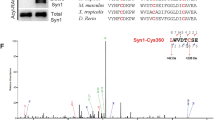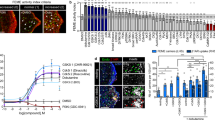Abstract
Synaptic vesicle endocytosis (SVE) is triggered by calcineurin-mediated dephosphorylation of the dephosphin proteins. SVE is maintained by the subsequent rephosphorylation of the dephosphins by unidentified protein kinases. Here, we show that cyclin-dependent kinase 5 (Cdk5) phosphorylates dynamin I on Ser 774 and Ser 778 in vitro, which are identical to its endogenous phosphorylation sites in vivo. Cdk5 antagonists and expression of dominant-negative Cdk5 block phosphorylation of dynamin I, but not of amphiphysin or AP180, in nerve terminals and inhibit SVE. Thus Cdk5 has an essential role in SVE and is the first dephosphin kinase identified in nerve terminals.
This is a preview of subscription content, access via your institution
Access options
Subscribe to this journal
Receive 12 print issues and online access
$209.00 per year
only $17.42 per issue
Buy this article
- Purchase on Springer Link
- Instant access to full article PDF
Prices may be subject to local taxes which are calculated during checkout








Similar content being viewed by others
References
Liu, J.P., Sim, A.T.R. & Robinson, P.J. Calcineurin inhibition of dynamin I GTPase activity coupled to nerve terminal depolarization. Science 265, 970–973 (1994).
Marks, B. & McMahon, H.T. Calcium triggers calcineurin-dependent synaptic vesicle recycling in mammalian nerve terminals. Curr.Biol. 8, 740–749 (1998).
Cousin, M.A., Tan, T.C. & Robinson, P.J. Protein phosphorylation is required for endocytosis in nerve terminals. Potential role for the dephosphins dynamin I and synaptojanin, but not AP180 or amphiphysin. J. Neurochem. 76, 105–116 (2001).
Cousin, M.A. Synaptic vesicle endocytosis: calcium works overtime in the nerve terminal. Mol. Neurobiol. 22, 115–128 (2000).
Cousin, M.A. & Robinson, P.J. The dephosphins: Dephosphorylation by calcineurin triggers synaptic vesicle endocytosis. Trends Neurosci. 24, 659–665 (2001).
Wenk, M.R. et al. PIP Kinase Iγ is the major PI(4,5)P2 synthesizing enzyme at the synapse. Neuron 32, 79–88 (2001).
Powell, K.A. et al. Phosphorylation of dynamin I on Ser-795 by protein kinase C blocks its association with phospholipids. J. Biol. Chem. 275, 11610–11617 (2000).
Marks, B. et al. GTPase activity of dynamin and resulting conformation change are essential for endocytosis. Nature 410, 231–235 (2001).
Shupliakov, O. et al. Synaptic vesicle endocytosis impaired by disruption of dynamin-SH3 domain interactions. Science 276, 259–263 (1997).
Gad, H. et al. Fission and uncoating of synaptic clathrin-coated vesicles are perturbed by disruption of interactions with the SH3 domain of endophilin. Neuron 27, 301–312 (2000).
Robinson, P.J. Dephosphin, a 96,000 dalton substrate of protein kinase C in synaptosomal cytosol is phosphorylated in intact synaptosomes. FEBS Lett. 282, 388–392 (1991).
Robinson, P.J. et al. Dynamin GTPase regulated by protein kinase C phosphorylation in nerve terminals. Nature 365, 163–166 (1993).
Hosoya, H. et al. Phosphorylation of dynamin by cdc2 kinase. Biochem. Biophys. Res. Commun. 202, 1127–1133 (1994).
Earnest, S., Khokhlatchev, A., Albanesi, J.P. & Barylko, B. Phosphorylation of dynamin by ERK2 inhibits the dynamin–microtubule interaction. FEBS Lett. 396, 62–66 (1996).
Chen-Hwang, M.-C., Chen, H.-R., Elzinga, M. & Hwang, Y.-W. Dynamin is a minibrain kinase/Dyrk1A substrate. J. Biol. Chem. 277, 17597–17604 (2002).
Songyang, Z. et al. A structural basis for substrate specificities of protein Ser/Thr kinases: primary sequence preference of casein kinases I and II, NIMA, phosphorylase kinase, calmodulin-dependent kinase II, CDK5, and Erk1. Mol. Cell. Biol. 16, 6486–6493 (1996).
Tomizawa, K. et al. Cdk5/p35 regulates neurotransmitter release through phosphorylation and downregulation of P/Q-type voltage-dependent calcium channel activity. J. Neurosci. 22, 2590–2597 (2002).
Matsubara, M. et al. Site-specific phosphorylation of synapsin I by mitogen-activated protein kinase and Cdk5 and its effects on physiological functions. J. Biol. Chem. 271, 21108–21113 (1996).
Shuang, R.Q. et al. Regulation of Munc-18 syntaxin 1A interaction by cyclin-dependent kinase 5 in nerve endings. J. Biol. Chem. 273, 4957–4966 (1998).
Floyd, S.R. et al. Amphiphysin binds the cdk5 regulatory subunit p35 and is phosphorylated by cdk5 and cdc2. J. Biol. Chem. 276, 8104–8110 (2001).
Hill, E., van der, K.J., Downes, C.P. & Smythe, E. The role of dynamin and its binding partners in coated pit invagination and scission. J. Cell Biol. 152, 309–324 (2001).
Grabs, D. et al. The SH3 domain of amphiphysin binds the proline-rich domain of dynamin at a single site that defines a new SH3 binding consensus sequence. J. Biol. Chem. 272, 13419–13425 (1997).
Meijer, L. et al. Biochemical and cellular effects of roscovitine, a potent and selective inhibitor of the cyclin-dependent kinases cdc2, cdk2 and cdk5. Eur. J. Biochem. 243, 527–536 (1997).
Davies, S.P., Reddy, H., Caivano, M. & Cohen, P. Specificity and mechanism of action of some commonly used protein kinase inhibitors. Biochem. J. 351, 95–105 (2000).
Cousin, M.A. et al. Synapsin I-associated phosphatidylinositol 3-kinase mediates synaptic vesicle delivery to the readily releasable pool. J. Biol. Chem. (cited 16 May 2003) DOI: 10.1074/jbc.M302386200 (2003).
Rosales, J.L., Nodwell, M.J., Johnston, R.N. & Lee, K.Y. Cdk5/p25(nck5a) interaction with synaptic proteins in bovine brain. J. Cell. Biochem. 78, 151–159 (2000).
Cousin, M.A. & Robinson, P.J. Ca2+ inhibition of dynamin arrests synaptic vesicle recycling at the active zone. J. Neurosci. 20, 949–957 (2000).
Koenig, J.H. & Ikeda, K. Disappearance and reformation of synaptic vesicle membrane upon transmitter release observed under reversible blockage of membrane retrieval. J. Neurosci. 9, 3844–3860 (1989).
Liu, J.P., Powell, K.A., Südhof, T.C. & Robinson, P.J. Dynamin I is a Ca2+-sensitive phospholipid-binding protein with very high affinity for protein kinase C. J. Biol. Chem. 269, 21043–21050 (1994).
Robinson, P.J. Differential stimulation of protein kinase C activity by phorbol ester or calcium/phosphatidylserine in vitro and in intact synaptosomes. J. Biol. Chem. 267, 21637–21644 (1992).
Robinson, P.J., Liu, J.P., Powell, K.A., Fykse, E.M. & Südhof, T.C. Phosphorylation of dynamin I and synaptic vesicle recycling. Trends Neurosci. 17, 348–353 (1994).
Dhavan, R., Tsai, L.H. & Tsai, L.H. A decade of cdk5. Nature Rev. Mol. Cell Biol. 2, 749–759 (2001).
Ohshima, T. et al. Targeted disruption of the cyclin-dependent kinase 5 gene results in abnormal corticogenesis, neuronal pathology and perinatal death. Proc. Natl Acad. Sci. USA 93, 11173–11178 (1996).
Kwon, Y.T., Tsai, L.H. & Crandall, J.E. Callosal axon guidance defects in p35(−/−) mice. J. Comp. Neurol. 415, 218–229 (1999).
Tsai, L.H., Takahashi, T., Caviness, V.S.J. & Harlow, E. Activity and expression pattern of cyclin-dependent kinase 5 in the embryonic mouse nervous system. Development 119, 1029–1040 (1993).
Bibb, J.A. et al. Effects of chronic exposure to cocaine are regulated by the neuronal protein Cdk5. Nature 410, 376–380 (2001).
Fletcher, A.I. et al. Regulation of exocytosis by cyclin-dependent kinase 5 via phosphorylation of munc18. J. Biol. Chem. 274, 4027–4035 (1999).
Li, B.S. et al. Regulation of NMDA receptors by cyclin-dependent kinase-5. Proc. Natl Acad. Sci. USA 98, 12742–12747 (2001).
Yan, Z., Chi, P., Bibb, J.A., Ryan, T.A. & Greengard, P. Roscovitine: a novel regulator of P/Q-type calcium channels and transmitter release in central neurons. J. Physiol. 540, 761–770 (2002).
Nicholls, D.G. The glutamatergic nerve terminal. Eur. J. Biochem. 212, 613–631 (1993).
Wilde, A. & Brodsky, F.M. In vivo phosphorylation of adaptors regulates their interaction with clathrin. J. Cell Biol. 135, 635–645 (1996).
Kariya, K. et al. Regulation of complex formation of POB1/epsin/adaptor protein complex 2 by mitotic phosphorylation. J. Biol. Chem. 275, 18399–18406 (2000).
Slepnev, V.I., Ochoa, G.C., Butler, M.H., Grabs, D. & DeCamilli, P. Role of phosphorylation in regulation of the assembly of endocytic coat complexes. Science 281, 821–824 (1998).
Rasmussen, R.K., Rusak, J., Price, G., Robinson, P.J. & Dorow, D.S. Mixed lineage kinase 2–SH3 domain binds dynamin and greatly enhances GTPase activation by phospholipid. Biochem. J. 335, 119–124 (1998).
Negash, S., Wang, H.S., Gao, C., Ledee, D. & Zelenka, P. Cdk5 regulates cell-matrix and cell-cell adhesion in lens epithelial cells. J. Cell Sci. 115, 2109–2117 (2002).
van den Heuvel, S. & Harlow, E. Distinct roles for cyclin-dependent kinases in cell cycle control. Science 262, 2050–2054 (1993).
Stowell, M.H., Marks, B., Wigge, P. & McMahon, H.T. Nucleotide-dependent conformational changes in dynamin: evidence for a mechanochemical molecular spring. Nature Cell Biol. 1, 27–32 (1999).
Wang, L.-H., Südhof, T.C. & Anderson, R.G. The appendage domain of α-adaptin is a high-affinity binding site for dynamin. J. Biol. Chem. 270, 10079–10083 (1995).
Micheva, K.D., Ramjaun, A.R., Kay, B.K. & McPherson, P.S. SH3 domain-dependent interactions of endophilin with amphiphysin. FEBS Lett. 414, 308–312 (1997).
Zhou, W., Merrick, B.A., Khaledi, M.G. & Tomer, K.B. Detection and sequencing of phosphopeptides affinity bound to immobilized metal ion beads by matrix-assisted laser desorption/ionization mass spectrometry. J. Am. Soc. Mass Spectrom. 11, 273–282 (2000).
Acknowledgements
This work was supported by grants from the Australian National Health and Medical Research Council (NHMRC to P.J.R.), the Cunningham Trust and Wellcome Trust (M.A.C.) and the Danish Natural Science Research Council (M.R.L.). We thank P. Rowe for critical reading of the manuscript. We also thank A. Quan (Children's Medical Research Institute), B. Hanna (Children's Medical Research Institute) and L. Deer (Institute of Clinical Pathology and Medical Research, Westmead Hospital) for valuable technical assistance. In addition, we also thank our colleagues listed in the constructs section for the plasmids required for this project.
Author information
Authors and Affiliations
Corresponding author
Ethics declarations
Competing interests
The authors declare no competing financial interests.
Supplementary information
Supplementary Information Fig. S1-S6
Supplementary Information Fig. S1a: Effect of cdk5 phosphorylation on dynamin's GTPase activity. (PDF 1528 kb)
Supplementary Information Fig. S2: Roscovitine inhibits dynamin I phosphorylation by cdk5 but not by PKC-α in vitro. is presented. Arrows indicate either dynamin I (Dyn) or synapsin I (Syn, doublet).
Supplementary Information Fig. S3: Lack of effect of PD 98059 on dynamin I phosphorylation and SVE.
Supplementary Information Fig. S4: Double pull-down of 4 dephosphins and synapsin from synaptosomes.
Supplementary Information Fig. S5; Morphology of synaptosomes at rest or after two cycles of stimulus- recovery.
Supplementary Information Fig. S6: Morphology of synaptosomes during S2 in the presence of roscovitine.
Supplementary Information Methods
Rights and permissions
About this article
Cite this article
Tan, T., Valova, V., Malladi, C. et al. Cdk5 is essential for synaptic vesicle endocytosis. Nat Cell Biol 5, 701–710 (2003). https://doi.org/10.1038/ncb1020
Received:
Accepted:
Published:
Issue Date:
DOI: https://doi.org/10.1038/ncb1020
This article is cited by
-
Involvement of Cdk5 activating subunit p35 in synaptic plasticity in excitatory and inhibitory neurons
Molecular Brain (2022)
-
Cdk5 and GSK3β inhibit fast endophilin-mediated endocytosis
Nature Communications (2021)
-
Core cell cycle machinery is crucially involved in both life and death of post-mitotic neurons
Cellular and Molecular Life Sciences (2020)
-
CB1R regulates CDK5 signaling and epigenetically controls Rac1 expression contributing to neurobehavioral abnormalities in mice postnatally exposed to ethanol
Neuropsychopharmacology (2019)
-
Roscovitine effectively enhances antitumor activity of temozolomide in vitro and in vivo mediated by increased autophagy and Caspase-3 dependent apoptosis
Scientific Reports (2019)



